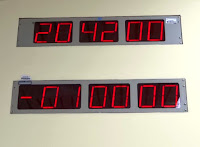This is the end of the MSG-4 launch campaign. After about three months in French Guiana to support this fantastic adventure, it is time to pack and fly back to our respective places in Europe.
Ohne Titel/Without Titel, Anreas Slominski (1959- ),
Museum der Bildenen Künste, Leipzig
The outstanding performance of the ThalesAlenia Space team was the key factor for the success all along this MSG saga which started more than twenty years ago and that culminated with the successful launch of MSG-4, the last spacecraft of the series on July 15th 2015. MTG (Meteosat Third Generation) will be now, as explained in the introduction, the next milestone.
This last postcard flags also the end of this blog. It has been a pleasure to share with you this campaign step by step. We hope, with this (almost) daily reporting, to have kept you informed properly and that you have also enjoyed the "side" messages which tried to enlarge the usual engineering fields. If you found some interest in reading us, it is definitely our best reward.
We wish you all the best in your new projects and enjoy now a well deserved summer break! Good bye MSG, good bye to all.
From French Guiana with love.
Kirill B.
PS:
Last news from MSG: it goes (very) well, all planned operations are running nominally (See MSG-4 milestones page).
Last but not least, the first MSG-4 image, will be published early August when it will be released by EUMETSAT.
We wish you all the best in your new projects and enjoy now a well deserved summer break! Good bye MSG, good bye to all.
From French Guiana with love.
Kirill B.
PS:
Last news from MSG: it goes (very) well, all planned operations are running nominally (See MSG-4 milestones page).
Last but not least, the first MSG-4 image, will be published early August when it will be released by EUMETSAT.



































